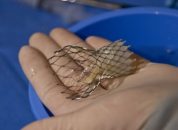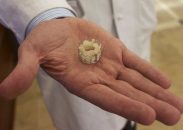Original Title: Hemodynamic Assessment of Aortic Regurgitation after Transcatheter Aortic Valve Replacement – The Diastolic Pressure-Time Index. Reference: Robert Höllriegel et al. JACC Cardiovasc Interv. 2016 Apr 16. Courtesy of Dr. Agustín Vecchia. In 2012 Sinning and collaborators presented a study in the “Journal of the American College of Cardiology” about an index…
Favorable Outcomes with New Generation Transcatheter Heart Valves in Bicuspids
Original Title: Bicuspid Aortic Valve Stenosis Favorable Early Outcomes UIT a Next-Generation Transcatheter Heart Valve in a Multicenter Study. Reference: Gidon Y. Perlman J Am Coll Cardiol Interv 2016;9:817-24 Courtesy of Dr. Carlos Fava. Congenital bicuspid aortic valves are infrequent and are associated with severe calcification in elderly patients. Transcatheter aortic valve replacement to treat bicuspid…
TAVI in asymptomatic severe aortic stenosis?
Original Title: Natural history, diagnostic approaches, and therapeutic strategies for patients with asymptomatic severe aortic stenosis. Reference: Généreux P et al. J Am Coll Cardiol. 2016; Epub ahead of print. Given that transcatheter aortic valve replacement (TAVI) is now being prescribed to lower risk patients, some wonder whether it is time to study the benefit…
TAVR with Sapien XT: similar to surgical replacement in intermediate risk patients
Original Title: Transcatheter or Surgical Aortic-Valve Replacement in Intermediate-Risk Patients. PARTNER 2A. Reference: Martin B. Leon et al. NEJM April 2, 2016 Courtesy of Dr. Juan A. Terré Studies have shown mortality rates after transcatheter aortic valve replacement (TAVR) and surgical aortic valve replacement (SAVR) in high risk patients are similar (PARTNER 2 – Cohort B). This is…
TAVI in Low-Flow / Low-Gradient
Original Title: Transcatheter Aortic Valve Implantation for Paradoxical Low-Flow Low-Gradient Aortic Stenosis Patients. Reference: Nicolas Debry et al. Catheter Cardiovasc Interv. 2016 Mar;87(4):797-804. Courtesy of Dr. Carlos Fava. Approximately 10 to 13% of low-flow low-gradient severe aortic stenosis cases (LF-LG) have preserved left ventricular function. Its physiopathology remains unclear and it has been associated with a…
TAVI in ≥90 year old patients: as beneficial as in younger patients
Original Title: Should Transcatheter Aortic valve replacement Be Performed in Nonagenarians? Insights from the STS/ACC TVT Registry. Reference: Mani Arsalan et al. J Am Coll Cardiol. 2016 Mar 29;67(12):1387-95. Courtesy of Dr. Carlos Fava The benefit of the transcatheter aortic valve replacement (TAVI) has already been shown in the general population undergoing this procedure. The number…
New York TAVR Registry: Trends in use and mortality at one year
Original Title: Utilization and 1-Year Mortality for Transcatheter Aortic Valve Replacement and Surgical Aortic Valve Replacement in New York Patients With Aortic Stenosis2011 to 2012. Reference:Hannan EL et al. J Am CollCardiolIntv. 2016;9(6):578-585. Courtesy of Dr. Agustín Vecchia It’s been only 14 years sinceCribierperformed the first transcatheter valve replacement. Today, during 2016, 100,000 patients are expected to…
PARTNER 2A: TAVI Not Inferior to Surgery in Intermediate Risk Patients
Transcatheter aortic valve replacement (TAVI) with the new generation balloon expandable valve is at least as good as surgery in intermediate risk patients with severe symptomatic aortic stenosis. For those that can be accessedfemorally, TAVI seems even better than surgery. In all, 2032 intermediate risk patients were randomized in 57 centers to TAVI with Sapien…
The SAPIEN 3 Valve Resulted Superior to Surgery in an Observational Study
The last generation of the balloon expandable valve resulted superior to surgery in intermediate riskpatients, in a registry analyzis. Patients treated with the SAPIEN 3 valve showed lower rates of death, stroke and paravalvular leak at one year than patients undergoing surgery. This third generation improves the SAPIEN XT with a skirt designed to prevent…
CoreValve US Pivotal: at 3 Years, the Self-Expanding Valve Maintains Its Advantage vs. Surgery
At 3 year follow up, the CoreValve US Pivotal study on high risk elderly patients, the self-expanding valve showed a lasting benefit vs. surgery. These findings could suggest that the self-expanding valve should be considered the preferred treatment in patients with symptomatic severe aortic stenosis at increased risk for surgery. The study included 797 patients…







